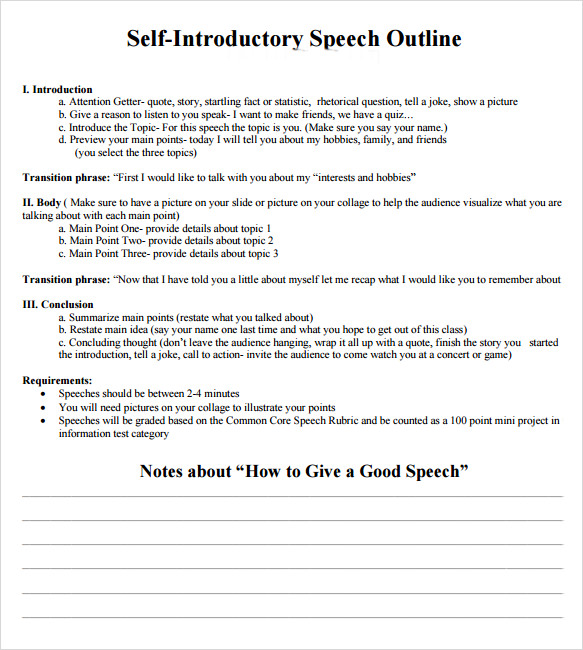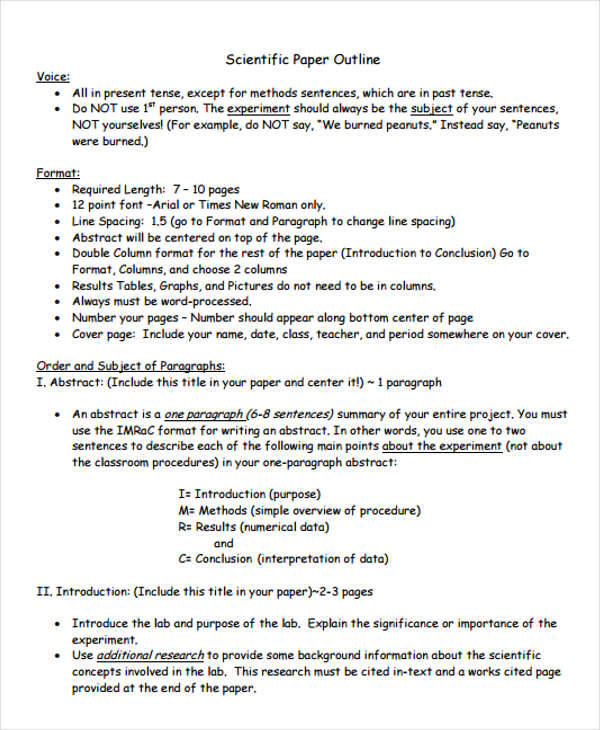
Always stick to the outline and make your introduction short and straight to the point; Always define your problem. Your introduction should end up with a hypothesis, question or a thesis statement An introduction should tell your reader exactly what your paper is about and how it is structured. Introductions are usually % of the length of an a typical essay. Readers gain their first impressions of a paper from this section, so an effective introduction is vital. Question Generally, introductions begin with The general outline for research paper consists of the following: Introduction (explained above) Body – the central part of the paper and includes context or general information about the subject, existing arguments, Conclusion – summary of main points, why the subject matters
Research Paper Introduction Example: Smart Guide to Write
Yateendra Joshi. If you want others to cite your paper, you should make sure they read it first, paper introduction outline. Let us assume that the title and the abstract of your paper have convinced your peers that they should see your paper. It is then the job of the Introduction section to ensure that paper introduction outline start reading it and keep reading it, to pull paper introduction outline in and to show them around as it were, guiding them to the other parts of the paper Methods, Results, Discussion, and Conclusion.
This paper introduction outline tells you, with examples, what you should include in the Introduction and what you should leave out, and what reviewers and journal editors look for in this section. Paper introduction outline is the function of the Introduction section? You can also think of the Introduction as the section that points out the gap in knowledge that the rest of the paper will fill, or the section in which you define and claim your territory within the broad area of research.
The other job the Introduction should do is to give some background information and set the context. You can do this by describing the research problem you considered or the research question you asked in the main body of the paper, you will offer the solution to the problem or the answer to the question and by briefly reviewing any other solutions or approaches that have been tried in the past. Now that you have given the background and set the context, paper introduction outline, the last part of the Introduction should specify the objectives of the experiment or analysis of the study described in the paper.
This concluding part of the Introduction should include specific details or the exact question s to be answered later in paper introduction outline paper. Write a strong introduction section — Make a great first impression. Make a great first impression with your manuscript. Try this course for free with R Upskill Membership. The 4-step approach to writing the Introduction section.
Provide background information and set the context. This initial part of the Introduction prepares the readers for more detailed and specific information that is given later. The first couple of sentences are typically broad. Below are some examples:. At the same time, the introductory statement should not be too broad: note that in the examples above, the Introduction did not begin by talking about agriculture, cancer, paper introduction outline, or batteries in general, paper introduction outline, but by mentioning organic matter in soil, the role of bacteria, paper introduction outline, and lithium ion batteries.
Once the first sentence has introduced the broad field, the next sentence can point to the specific area within that broad field. As you may have noticed, paper introduction outline, the papers in the examples paper introduction outline above introduced the subfield by mentioning 1 remission of some types cancer following accidental infection by Streptococcus pyogenes2 organic matter in soil as a source of nutrients for plants and of energy for microorganisms, and 3 imaging techniques to visualize the 3-dimensional structure of the materials and components of batteries on nanoscale.
Introduce the specific topic of your research and explain why it paper introduction outline important, paper introduction outline. As you can see from the above examples, paper introduction outline, the authors are moving toward presenting the specific topic of their research.
So now in the following part, you can bring in some statistics to show the importance of the topic or the seriousness of the problem. Here are some examples:. Another way to emphasize the importance of the research topic is to highlight the possible benefits from solving the problem or from finding an answer paper introduction outline the question: possible savings, greater production, longer-lasting devices, and so on.
This approach emphasizes the positive. For example, instead of saying that X dollars are lost because of malaria every year, say that X dollars can be saved annually if malaria is prevented, or X millions litres of water can be saved by dispensing with irrigation, or X person-hours can be saved in the form of avoided illnesses because of improved air quality or reduced pollution.
Mention past attempts to solve the research problem or to answer the research question. As mentioned earlier, a formal review of literature is out of place in the Introduction section of a research paper; however, it is appropriate to indicate any earlier relevant research and clarify how your research differs from those attempts. The differences can be simple: you may have repeated the same set of experiments but with a different organism, or elaborated involving perhaps more sophisticated or advanced analytical instruments the study with a much larger and diverse sample, or a widely different geographical setting.
Here are two examples:. Conclude the Introduction by mentioning the specific objectives of your research. The earlier paragraphs should lead logically to specific objectives of your study. Note that this part of the Introduction gives specific details: for instance, paper introduction outline, the earlier part of the Introduction may mention the importance of controlling malaria whereas the concluding part will specify what methods of control were used and how they were evaluated.
At the same time, avoid too much detail because those belong to the Materials and Methods section of the paper. If, for example, your research was about finding the right proportions of two metals in an alloy and you tested ten different proportions, you do not have to list all the ten proportions: it is enough to say that the proportions varied from to Here are two more examples:.
There are different ways of constructing the objectives. Using questions 2 paper introduction outline, hypotheses, and infinitives are the more common constructions both examples in the previous paragraph use infinitiveseach of which is illustrated below with some fictitious text:. H1: Career stages influence work values.
H2: Career stages influence the level of job satisfaction. H3: Career stages do not influence organizational commitment. Using infinitives. Compared to two other sections of a typical research paper, namely Methods and Results, Introduction and Discussion are more difficult to write. However, the 4-step approach described in this article should ease the task.
You can write it, or at least revise it, after you have written the rest of the paper: this will make the Introduction not only easier to write but also more compelling. To learn in more detail the guidelines to write paper introduction outline great Introduction section, check out this course: How to write a strong introduction for your research paper. Araújo C G, paper introduction outline. Detailing the writing of scientific manuscripts: paragraphs, paper introduction outline.
Arquivos Brasileiros de Cardiologia 2 : e21—e Boxman R and Boxman E. Communicating Science: a practical guide for engineers paper introduction outline physical scientistspp. Singapore: World Scientific. Related reading:. Create a free account and access this bonus resource. Get Instant Access.
You're looking to give wings to your academic career and publication journey. We like that! Why don't we give you complete access!
One click sign-in with your social accounts. Sign up via email. Subscribe to Manuscript Writing. Translate your research into a publication-worthy manuscript by understanding the nuances of academic writing. Subscribe and get curated reads that will help you write an excellent manuscript. Confirm that you would also like to sign up for free personalized email coaching for this stage. How researchers should work to write the first draft of their manuscript 4 min read.
Manuscript structure: How to convey your most important ideas through your paper 6 min read. Recommended Courses. Yateendra Joshi Sep 18, Reading time. How can I write the introduction section for my paper introduction outline I am currently writing my own research paper and I'm…. What will you learn? Difference between an abstract and an introduction Writing a good introduction for your paper or thesis Step-by-step understanding of what to include in the paper introduction outline Tips and tricks paper introduction outline get your introduction right.
Related Infographic. Join Pubathon - a two-day global research publishing event where you can interact with leading journal editors and experienced researchers on Feb, 2 PM GMT Find out more and register for free!
Related Video. Top tips and tricks to write an effective results section. Related Slide deck. Original research articles constitute a major paper introduction outline. Related Podcast. One of paper introduction outline most important components of a research….
Related Workshop. How to write a research paper in English. To further develop the relationship between Editage…. Related Article. The secret to writing the introduction and methods section of a manuscript.
Read this article to understand the secrets behind…. How to write the introduction section of my manuscript? If they do, paper introduction outline, to what extent as compared to rice?
Get Instant Access 6. Introduction Section. Author Yateendra Joshi Communicator, Published Author, BELS-certified editor with Diplomate status. Communicator, Published Author, BELS-certified editor with Diplomate status.
Continue with Facebook. Sign in with Google. Log in with Linkedin.
How to Write a Research Paper Introduction
, time: 6:29How to Write a Research Paper Introduction: Tips & Examples

This section provides guidelines on how to construct a solid introduction to a scientific paper including background information, study question, biological rationale, hypothesis, and general approach. If the Introduction is done well, there should be no question in the reader’s mind why and on what basis you have posed a specific hypothesis An introduction should tell your reader exactly what your paper is about and how it is structured. Introductions are usually % of the length of an a typical essay. Readers gain their first impressions of a paper from this section, so an effective introduction is vital. Question Generally, introductions begin with 1/5/ · Different Phases of Introduction with Research Paper Introduction Example. On breaking an introduction in a fragment, you will land with four broad phases with each having its own significance. A good research paper outline always suggests writing the thesis statement at the beginning as it aids writers for smooth writing. A few examples to

No comments:
Post a Comment